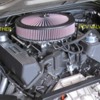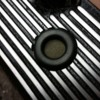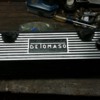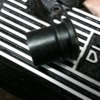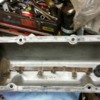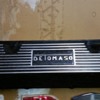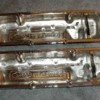quote:
Originally posted by 1Rocketship:
This quote by Pantera Doug, makes me question his "sanity"/"level of insanity" even MORE!


"The Cleveland valve covers and head in particular retain about 3 inches of oil in the valve cover to cool the valve springs".
So I wondered...How many quarts of oil would it take to fill a OEM 351 Cleveland valve cover up to a height of "3 inches"??!! & then subsequently HOW MANY quarts would be remaining in the oil pan?!
Once I get to my Top Secret, Highly Fortified, Miles beneath the surface Underground Testing lab, I will report back my undeniable, indisputable, beyond reproach test conclusions...Mark
This is why you check the oil level when the engine is NOT running. The oil level in the pan is designed with those considerations in mind.
Chronologically the Cleveland is after the 428cj, but not by much.
That entire engine series, the FE was introduced as a 352 in 1958. It was raced highly in NASCAR, road racing, and always was seriously drag raced so it IS a bit of a head scratcher that it took this long for Ford to realize there was an "issue"?
Some of my friends say that I am harsh. What do you call Chevy calling Ford the "numb nuts engineering department"?
Soon after the 428cj was introduced as a 1/2 year model in 1968 (model year), chronologically about late April 1968, Ford started to get complaints from dealers that they were replacing engines on warranty, because the engines had been run out of oil.
It seems that if you turn the engine over 6,000 rpm for sustained periods of time, the oil pan gets pumped dry.
That was with 4.5 qts in the pan and .5 in the filter.
There were a series of fixes. The first one was just to add an extra quart of oil in engines already in service.
Ford made a quick change in remarking or recalibrating the dipstick in production. They didn't change the part number, just remarked the stick. Still a C7AE
That was STILL problematic, i.e, owners were STILL ka-booming these things.
Next thing to do was issue a new part number dipstick to D0AE with a TWO QUART recalibration.
Now this created a little bit of a problem. They couldn't redesign the oil pan, it would be too deep, and with two extra quarts, the crankshaft was beginning to spin in the oil in the pan because of the higher level at low rpms.
This is the point at which they added a "windage tray" to the 70 and up 428cj's. It was to aid in this issue.
So if you had a pre-68 428, by this engineering change you were running the engine one quart low even though the dipstick said it was right. At one quart low, you were actually two quarts low. But wait, it gets better.
If you had a 68 or 69 428cj, the 1970 change said that engine was now 1 quart low even though it had a revised (remarked dipstick) saying it was right, and if you had a '67, like my 67 GT500 you were now TWO QUARTS low even though, yada, yada, yada, the dipstick said you were ok.
Got that?
So anyway, on all engines, you wind up with somewhere around two to three quarts of oil up in the valve covers when the engine is turning say 5,000 rpm?
Don't believe me? Put a set of clear plastic valve covers on the car and run it up to 5,000, and see where the oil is?
Now when NASCAR decided to attempt to slow the cars down, after the 429 "Shotgun" (Boss 429 in street terms) they went to the 5.7 liter displacement limits which if you were in the Ford camps meant at the time essentially a Boss 351 Cleveland.
Intitially those engines were dropping valves in competition. Running 500 miles at wide open throttle at over 7,500 rpm was showing issues with the valve train.
The fix turned out to be realively simple. Restrict the drain back holes into the oil pan and retain more oil, or more correctly just enough to submerge part of the valve spring in it, to provide a cooling effect on them. It worked.
Ford Engineering, being what it was saw this as a good idea and essentially incorporated that into production heads.
Actually all US production engines do it. It's really just how the drain backs are calibrated to the oil pan.
There is no secret at all that if you are going to run a Pantera hard, i.e., over 5,000 rpm for extended periods of time, maybe like you might see in Germany on the Autoban, a stock oil pan is suicidal.
Why? Go back and read the part about the 428cj's. If you can't remember it, write it down on your crip sheet, because it's going to be on the test.
I will allow that for you old acid head hippies that still when I say, "hey, how you doin'?", still go "huh, what Man?" Try and focus a little ok? That gets a little embarrassing?

...and Mark, where exactly did you read anywhere that I wrote, that I said I am not crazy?
I am. It's just manageable, until you bring up things like MM? Remember, just don't say, "Niagara Falls", ok?

Calling ME CRAZY is completely acceptable to me. I even agree. Just don't call me "normal", that will get me seriously pissed.



